Organotypic specificity of key RET adaptor-docking sites in the pathogenesis of neurocristopathies and renal malformations in mice
- PMID: 20160347
- PMCID: PMC2827965
- DOI: 10.1172/JCI41619
Organotypic specificity of key RET adaptor-docking sites in the pathogenesis of neurocristopathies and renal malformations in mice
Abstract
The receptor tyrosine kinase ret protooncogene (RET) is implicated in the pathogenesis of several diseases and in several developmental defects, particularly those in neural crest-derived structures and the genitourinary system. In order to further elucidate RET-mediated mechanisms that contribute to these diseases and decipher the basis for specificity in the pleiotropic effects of RET, we characterized development of the enteric and autonomic nervous systems in mice expressing RET9 or RET51 isoforms harboring mutations in tyrosine residues that act as docking sites for the adaptors Plcgamma, Src, Shc, and Grb2. Using this approach, we found that development of the genitourinary system and the enteric and autonomic nervous systems is dependent on distinct RET-stimulated signaling pathways. Thus, mutation of RET51 at Y1062, a docking site for multiple adaptor proteins including Shc, caused distal colon aganglionosis reminiscent of Hirschsprung disease (HSCR). On the other hand, this mutation in RET9, which encodes an isoform that lacks the Grb2 docking site present in RET51, produced severe abnormalities in multiple organs. Mutations that abrogate RET-Plcgamma binding, previously shown to produce features reminiscent of congenital anomalies of kidneys or urinary tract (CAKUT) syndrome, produced only minor abnormalities in the nervous system. Abrogating RET51-Src binding produced no major defects in these systems. These studies provide insight into the basis of organotypic specificity and redundancy in RET signaling within these unique systems and in diseases such as HSCR and CAKUT.
Figures

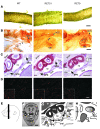

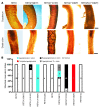
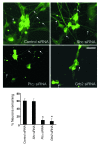
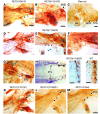
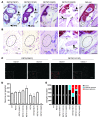

Similar articles
-
Critical and distinct roles for key RET tyrosine docking sites in renal development.Genes Dev. 2006 Feb 1;20(3):321-33. doi: 10.1101/gad.1387206. Genes Dev. 2006. PMID: 16452504 Free PMC article.
-
Distinct turnover of alternatively spliced isoforms of the RET kinase receptor mediated by differential recruitment of the Cbl ubiquitin ligase.J Biol Chem. 2005 Apr 8;280(14):13442-9. doi: 10.1074/jbc.M500507200. Epub 2005 Jan 27. J Biol Chem. 2005. PMID: 15677445
-
Two distinct mutations of the RET receptor causing Hirschsprung's disease impair the binding of signalling effectors to a multifunctional docking site.Hum Mol Genet. 1999 Oct;8(11):1989-99. doi: 10.1093/hmg/8.11.1989. Hum Mol Genet. 1999. PMID: 10484767
-
Developmental determinants of the independence and complexity of the enteric nervous system.Trends Neurosci. 2010 Oct;33(10):446-56. doi: 10.1016/j.tins.2010.06.002. Epub 2010 Jul 13. Trends Neurosci. 2010. PMID: 20633936 Review.
-
Hirschsprung's disease as a model of complex genetic etiology.Histol Histopathol. 2013 Sep;28(9):1117-36. doi: 10.14670/HH-28.1117. Epub 2013 Apr 19. Histol Histopathol. 2013. PMID: 23605783 Review.
Cited by
-
A Single RET Mutation in Hirschsprung Disease Induces Intestinal Aganglionosis Via a Dominant-Negative Mechanism.Cell Mol Gastroenterol Hepatol. 2023;15(6):1505-1524. doi: 10.1016/j.jcmgh.2022.12.003. Epub 2022 Dec 13. Cell Mol Gastroenterol Hepatol. 2023. PMID: 36521661 Free PMC article.
-
ChIP-Seq-Based Approach in Mouse Enteric Precursor Cells Reveals New Potential Genes with a Role in Enteric Nervous System Development and Hirschsprung Disease.Int J Mol Sci. 2020 Nov 28;21(23):9061. doi: 10.3390/ijms21239061. Int J Mol Sci. 2020. PMID: 33260622 Free PMC article.
-
The developmental etiology and pathogenesis of Hirschsprung disease.Transl Res. 2013 Jul;162(1):1-15. doi: 10.1016/j.trsl.2013.03.001. Epub 2013 Mar 22. Transl Res. 2013. PMID: 23528997 Free PMC article. Review.
-
Multidisciplinary approaches for elucidating genetics and molecular pathogenesis of urinary tract malformations.Kidney Int. 2022 Mar;101(3):473-484. doi: 10.1016/j.kint.2021.09.034. Epub 2021 Nov 12. Kidney Int. 2022. PMID: 34780871 Free PMC article. Review.
-
MiR-195-5p inhibits proliferation and invasion of nerve cells in Hirschsprung disease by targeting GFRA4.Mol Cell Biochem. 2021 May;476(5):2061-2073. doi: 10.1007/s11010-021-04055-y. Epub 2021 Jan 30. Mol Cell Biochem. 2021. PMID: 33515383
References
Publication types
MeSH terms
Substances
Grants and funding
- DK081644/DK/NIDDK NIH HHS/United States
- DK6459201/DK/NIDDK NIH HHS/United States
- R01 DK082531/DK/NIDDK NIH HHS/United States
- DK57038/DK/NIDDK NIH HHS/United States
- AG013730/AG/NIA NIH HHS/United States
- HD047396/HD/NICHD NIH HHS/United States
- P30-DK079333/DK/NIDDK NIH HHS/United States
- R01 DK081644/DK/NIDDK NIH HHS/United States
- R01 DK057038/DK/NIDDK NIH HHS/United States
- P30 DK079333/DK/NIDDK NIH HHS/United States
- R01 AG013730/AG/NIA NIH HHS/United States
- DK082531/DK/NIDDK NIH HHS/United States
- K08 HD047396/HD/NICHD NIH HHS/United States
LinkOut - more resources
Full Text Sources
Molecular Biology Databases
Research Materials
Miscellaneous

